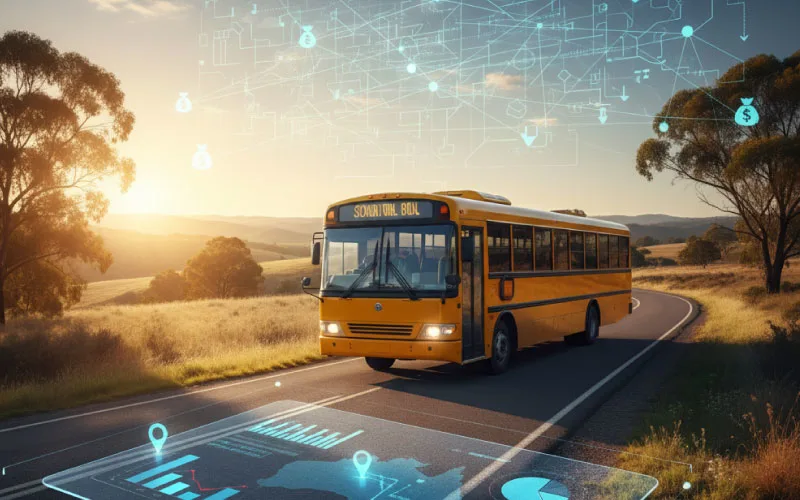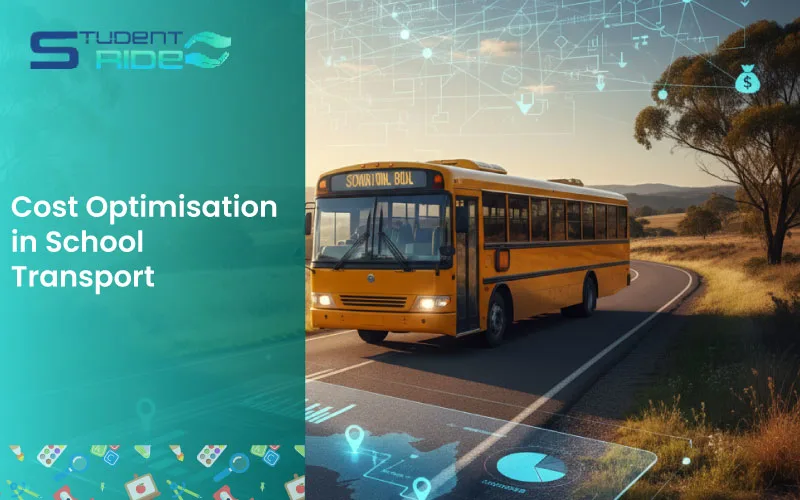Why Data Matters in School Transport
Independent schools across Australia are under growing financial pressure. Rising fuel costs, stricter compliance requirements, and higher expectations from parents mean transport budgets are stretched thin. Leaders can no longer rely on intuition alone—data-driven approaches are the key to reducing expenses while maintaining safety and efficiency.
From route optimisation to predictive scheduling, schools now have access to tools that provide actionable insights. By turning numbers into smarter decisions, independent schools can unlock significant savings without compromising on safety or service quality.
The Rising Costs of School Transport
Fuel and Vehicle Maintenance
Fuel is one of the largest recurring costs. Combined with regular servicing, tyres, and unexpected repairs, maintenance expenses can quickly spiral. Older buses are particularly costly to run, making efficiency even more critical.
Driver Wages and Compliance Obligations
Driver salaries are essential, but compliance adds further weight. Working With Children Checks, police clearances, and ongoing training all contribute to costs. Schools that lack automated compliance tracking often overspend on manual admin.
Insurance and Liability
Comprehensive insurance is a non-negotiable. However, inefficient operations—such as frequent claims or poor maintenance—can raise premiums. Data-driven risk monitoring helps keep these costs under control.

Where Inefficiencies Drain Budgets
Underutilised Buses and Empty Routes
One of the most common budget drains is underused capacity. Running a 40-seat bus for just 12 students wastes fuel, driver time, and resources.
Manual Administration and Paper Records
Admin teams often spend hours coordinating schedules, logging attendance, and producing compliance reports. These repetitive tasks inflate costs and take time away from higher-value responsibilities.
Poorly Planned Timetables
Without data, route planning becomes guesswork. Inefficient timetables can mean longer journeys, parent dissatisfaction, and higher running costs.
Data-Driven Decision Making in School Transport
Leveraging Real-Time Tracking Data
GPS-enabled systems provide live updates on bus locations. Analysing this data helps schools identify delays, optimise traffic avoidance, and refine route efficiency.
Analysing Route Efficiency and Utilisation Rates
By reviewing ridership data, schools can see which buses are consistently underutilised and adjust capacity accordingly.
Using Predictive Analytics for Scheduling
Historical data—on attendance, seasonal trends, and traffic—can be fed into AI models to predict demand. This ensures routes are prepared for real-world conditions, reducing wasted kilometres.
Practical Tools for Smarter Cost Management
Transport Dashboards and Analytics Platforms
Centralised dashboards consolidate data on routes, fuel use, attendance, and costs, making it easier for leaders to spot inefficiencies.
RFID Check-In Systems for Accurate Data
RFID cards or tags automatically record when students board or leave. This prevents missed stops, improves accuracy, and helps schools monitor true seat utilisation.
Parent Portals to Reduce Admin Work
Instead of constant phone calls, parents can access real-time updates on their child’s journey. This transparency cuts down on staff workload and improves satisfaction.
Case Study: Data-Driven Savings in Action
The Problem: Escalating Costs and Complaints
A Sydney independent school faced rising costs due to inefficient routing, low bus occupancy, and parent frustration over poor communication.
The Solution: Implementing Analytics and Tracking
The school adopted a transport management platform with:
- AI-powered routing
- RFID student check-ins
- Real-time GPS tracking and parent portal
The Results: Savings and Higher Parent Satisfaction
- 18% reduction in annual fuel costs
- 25% improvement in seat utilisation
- Significant reduction in parent complaints
- Admin hours cut in half through automated reporting
Environmental Benefits of Data-Led Transport Optimisation
Fewer Kilometres Driven Equals Lower Emissions
Smarter routing reduces unnecessary journeys, directly lowering the school’s carbon footprint.
Aligning Transport with Sustainability Policies
Independent schools increasingly promote sustainability. Data-driven transport supports these commitments, making operations both eco-friendly and cost-efficient.
Overcoming Barriers to Data-Driven Transport
Addressing Staff Training Needs
Staff may resist new tools due to lack of familiarity. Hands-on training and intuitive platforms ease the transition.
Reducing Concerns About Costs of Implementation
While technology requires initial investment, the long-term savings in fuel, wages, and admin outweigh upfront costs.
Building Parent Confidence in New Systems
Parents may worry about privacy or reliability. Transparent policies and visible benefits—such as live updates—quickly build trust.
FAQs on Data-Driven School Transport Optimisation
Q1: How do schools start using data to cut transport costs?
Begin by collecting baseline data on routes, ridership, and expenses, then identify inefficiencies to target.
Q2: Do data-driven tools require a large budget?
Not necessarily. Many platforms scale to suit small, medium, or large schools.
Q3: How quickly do schools see cost savings?
Most schools report measurable savings within the first 6–12 months.
Q4: Can these systems integrate with existing school software?
Yes, platforms like StudentRide integrate seamlessly with attendance and scheduling systems.
Q5: What about student privacy?
Modern systems comply with privacy standards, ensuring secure handling of student information.
Q6: Are parents supportive of data-driven transport?
Yes—parents appreciate the transparency, safety, and reliability that come with smarter systems.
Conclusion: Smarter Insights, Lower Costs
Independent schools don’t need to accept rising transport costs as inevitable. By adopting data-driven approaches, leaders can reduce expenses, improve safety, and deliver a smoother experience for students and parents alike.
The future of school transport lies in turning data into action—unlocking savings, efficiency, and confidence in every journey.
